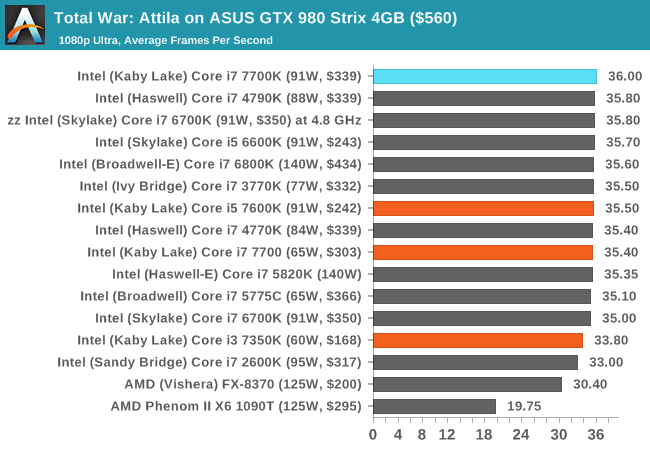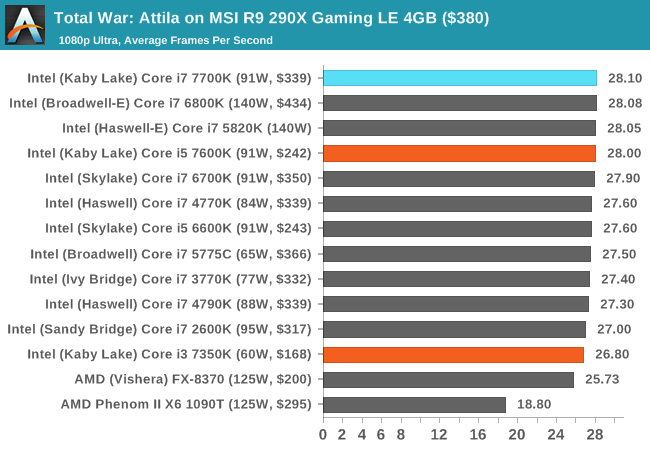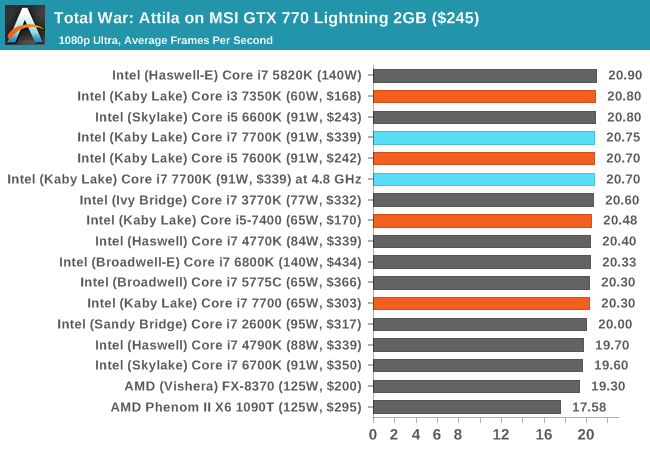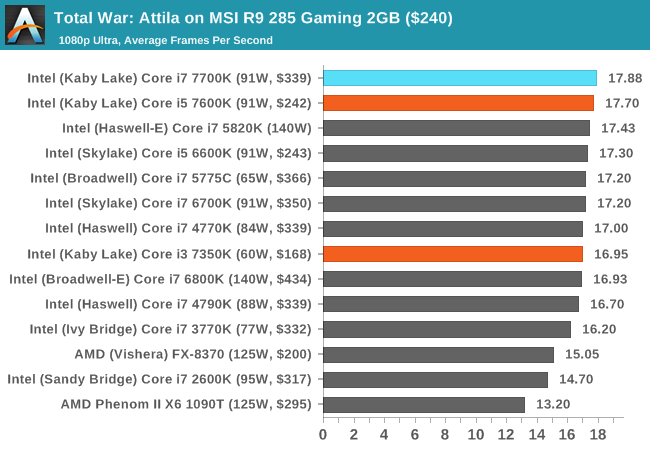The Intel Core i7-7700K (91W) Review: The New Out-of-the-box Performance Champion
by Ian Cutress on January 3, 2017 12:02 PM ESTTotal War: Attila
The Total War franchise moves on to Attila, another The Creative Assembly development, and is a stand-alone strategy title set in 395AD where the main story line lets the gamer take control of the leader of the Huns in order to conquer parts of the world. Graphically the game can render hundreds/thousands of units on screen at once, all with their individual actions and can put some of the big cards to task.
For low end graphics, we test at 720p with performance settings, recording the average frame rate. With mid and high range graphics, we test at 1080p with the quality setting. In both circumstances, unlimited video memory is enabled and the in-game scripted benchmark is used.
















125 Comments
View All Comments
Toss3 - Tuesday, January 3, 2017 - link
TBH they shouldn't just post mins, but decent FCAT analyses like the ones over on Guru3d.comUser.Name - Tuesday, January 3, 2017 - link
Well that involves a lot more hardware and time to record/analyze the results, which is why I suggested looking at minimum framerates. But you're right that would be a good improvement too.edzieba - Tuesday, January 3, 2017 - link
"For one thing, average framerates are meaningless when doing CPU tests. You need to be looking at minimum framerates."Framerate needs to be dropped entirely. Instead, frame render times (specifically range and variance) give a better picture of perceived 'responsiveness', as well as render times being convertible to an FPS value (though not vice versa).
Alexvrb - Tuesday, January 3, 2017 - link
Agreed, when reviewing CPUs it would stand to reason that you'd want to use games that tax the CPU.Notmyusualid - Friday, January 6, 2017 - link
Your second link there was especially interesting - thats why I went for more cores than four.My 14C/28T Xeon has to feed 2x 1070 FTWs. I don't think quad core & multi-gpu are that great together, in my experience.
For all the talk about games don't use more than 'x' cores, I see my cores / threads nicely loaded up for many games. Even MW3 shows activity over 12 Threads, however small, and thats old now.
I just got a 6950X for a song, and the scouser seller backed out on me AFTER I paid. So I get to wait 5 to 7 working days for my money back (thanks PayPal), and I won't get to see how much frequency would have affected my everyday computing. I won't be paying north of 1400 GBP for one, that I can tell you.
Mondozai - Tuesday, January 3, 2017 - link
Who the fuck is testing with GTX 980@1080p? It should be a GTX 1080@1080p because as games' visual demands go up progressively, it will show how the processor ages. This review is useless from that regard.Go to Sweclockers or any other website for a real review. AT has fallen so fucking much it's hilarious.
Gasaraki88 - Tuesday, January 3, 2017 - link
Yeah... surprisingly Tom's Hardware has really indepth reviews now a days just like the olden times. Considering that Microsoft has said that OSes lower than Windows 10 will not be supported on Kaby Lake, i'm surprised they are still using Windows 7 to to their tests.Shadowmaster625 - Tuesday, January 3, 2017 - link
There are lots of people that use a 980 with something like a 2500k or 2600k and might be wondering what a new cpu would do for them.dakishimesan - Tuesday, January 3, 2017 - link
Also using the same testing setup allows the results to be directly comparable to previous chips. They already mentioned in one of the articles regarding Kaby Lake (I think it was the i5 review) that they will be rolling out a new testbed and testing suite in February.BrokenCrayons - Tuesday, January 3, 2017 - link
From the Test Bed and Setup page:"This is also typically run at JEDEC subtimings where possible."
-and-
"Our testing methodology is ‘out-of-the-box’, with the latest public BIOS installed and XMP enabled, and thus subject to the whims of this feature."
After reading those two lines, I really don't know what Anandtech's memory settings were like for this article.